To understand Argentina’s struggle to be competitive, consider the plight of the Hansa Oslo.
Freshly laden with a cargo of soybean oil on the banks of the Paraná River, the tanker set sail destined for India — only to come to a grinding halt eight miles downstream as its keel dug into a thick layer of silt.
The scene in November was all too familiar. Ships in the Paraná run aground roughly once a month, blocking the busy navigation channel for hours or even days at a time. The river snarl-ups are more than just a nuisance: they’re threatening the very viability of Argentina’s crop export industry, worth some US$30 billion a year, as well as President Javier Milei’s vision to turn around its failed economy once and for all.
That’s why Milei is moving to give the neglected waterway its first major upgrade in nearly two decades. But time is running out for the fixes to be made if Argentina is to prevent neighbouring Brazil — where maritime infrastructure is already rapidly expanding — from building an insurmountable lead as Latin America’s agricultural powerhouse.
“Brazil is leaving us behind, and if we delay any further we’ll inevitably lose even more competitiveness,” said Antonio Sánchez, an Argentine shipping infrastructure expert at Panama-based consultancy firm Talasonomica.
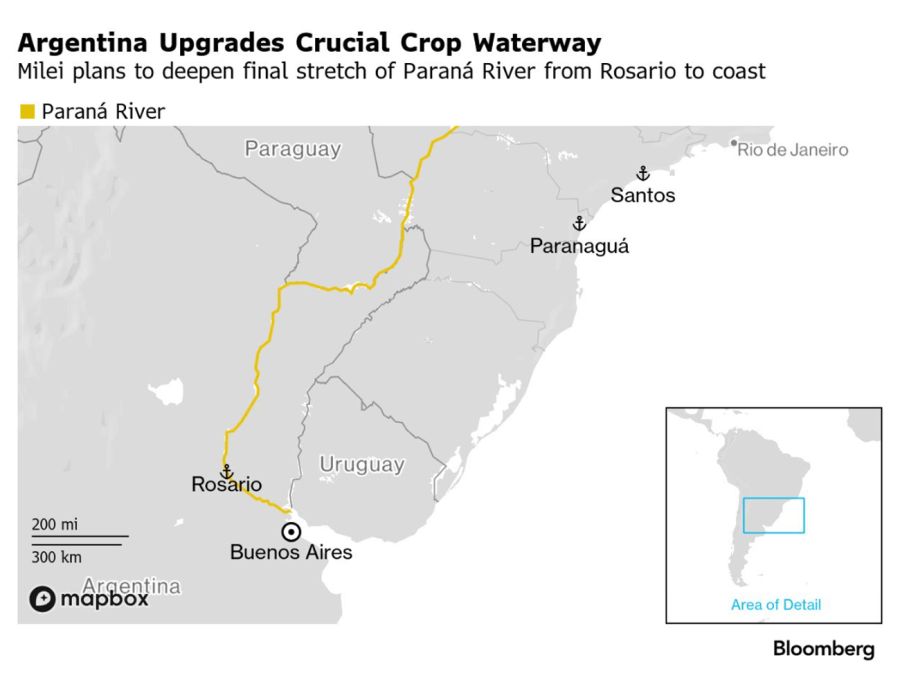
The Paraná is Argentina’s gateway to global markets. Around 80 percent of all the country’s crops are loaded on its shores. But the shipping channel hasn’t been deepened since 2006 — even as global soy commerce has doubled in the same period.
The shallow waters mean that exporters in Argentina can’t load a typical Panamax ship as in rival Brazil. Instead, vessels sailing out of the Paraná have to anchor again at Atlantic ports to top up their cargoes, either at Argentina’s Bahía Blanca, or at Brazil’s Santos or Paranaguá. The detours cost hundreds of millions of dollars every year.
The efficiency of having a shipping route run right beside prime farm acreage spurred the world’s biggest agriculture traders, like Bunge Global SA, Cargill Inc, Louis Dreyfus Co and Viterra Inc, to build a vast industrial complex for processing soybeans by the riverside city of Rosario. The development, which started in the 1990s, made Argentina the number one exporter of soy meal, a livestock feed, and soy oil, used in food and biofuels.
Now, the country is trying to regain the logistics advantage that lured the traders in the first place.
“Taming the raging river to create the waterway was one of the greatest success stories in nautical history,” said Sergio Borelli, who navigated the Paraná for years as a ship pilot. “But within 10 to 15 years we realised that we had too many ships and a channel whose dimensions were too small for what we were aspiring to do. It needs to be deeper, wider, longer.”
So it was a relief late last year when Milei’s government published the terms of a new dredging deal, including a key provision to deepen the waterway to 39 feet (11.9 metres) from 36 feet within five years, and the possibility of digging even deeper — though it’s unclear what impact excavating so much silt will have on cherished wetlands.
That squares with Milei’s vow to unleash the full potential of Argentina’s beleaguered farmers. The country depends on them for hard-currency revenue, which is vital to achieving sustained economic growth. But they have long been hampered by the government’s habit of taxing and meddling in exports — all while watching port expansions in Brazil keep pace with its remarkable crop boom.
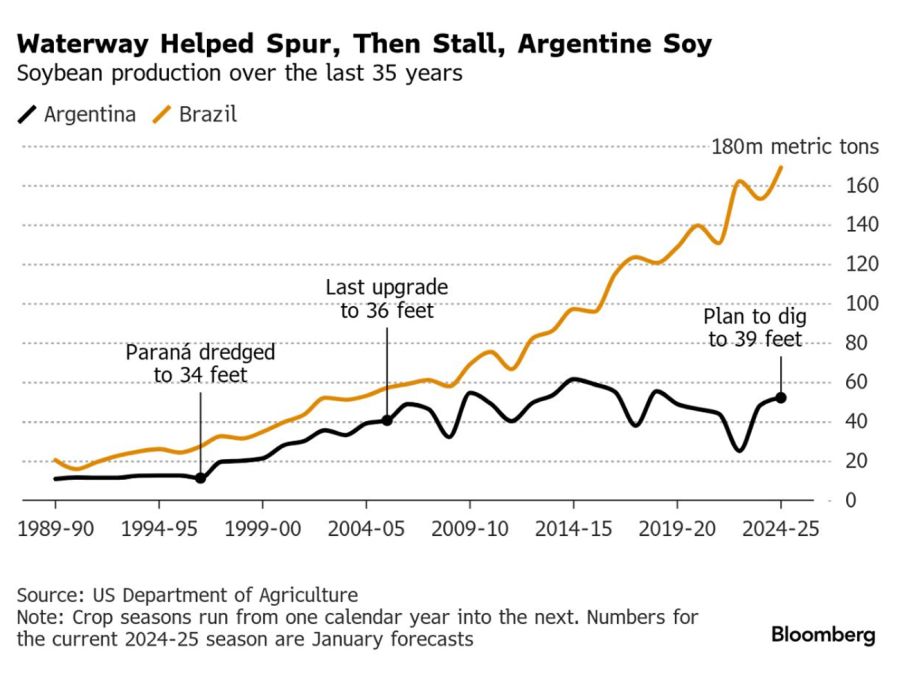
Dredgers have until Wednesday to submit offers for the contract, with companies from Belgium and Denmark circling. In the recent past, China’s CCCC Shanghai Dredging Co has also expressed interest, but Milei officials have excluded state-controlled entities from bidding.
The tender also comes after the contract to maintain the waterway was allowed to expire a few years ago, which spawned administrative inefficiencies that shippers are paying for with recent hikes to river tolls.
When Spanish colonisers started pillaging Potosí Mountain in modern-day Bolivia in the 16th century, they sent its precious metals out along the Paraná, through expanses of rainforest and pampas, lending the exit point near Buenos Aires its name — Río de la Plata, or silver river estuary.
Hundreds of years later, Belgium’s Jan de Nul NV carved out today’s navigation channel. That allowed seafaring tankers and bulk carriers to sail hundreds of miles inland from the Atlantic Ocean and the Paraná became an expressway for exports, much like the Mississippi and China’s Yellow River. In addition to crops, the Paraná is used by steel exporters, fertiliser importers, and in the fuel and automotive trades.
But as the Paraná turned from a prized asset into a liability, climate change exacerbated challenges faced by mariners as Argentina endured several droughts over the last few years. With its narrow passes and peculiar changes in draft, ships must waste precious time waiting for ocean tides to swell the channel and provide navigable water levels.
“The waterway is old-fashioned; it’s essential to bring it into the modern era,” said Alfredo Sesé, a freight transportation expert at the Rosario Board of Trade. “Without improvement we run the risk of stagnant industrial production, disinvestment in ports and soy processing, and, in turn, a reduction in dollar inflows to the economy.”
To be sure, the Milei tender has come under criticism, including from export and maritime groups who want a requirement for the channel to go deeper than 39 feet in order to fully load Panamax ships with soy meal. That, they say, would truly help close the gap with Brazil.
“We have to go straight to 42 feet,” said Guillermo Wade, head of port group CAPyM in Rosario. “Otherwise it’ll be futile.”
related news
by Jonathan Gilbert, Bloomberg








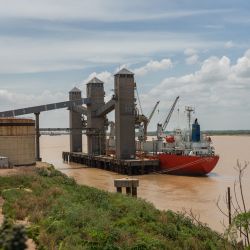
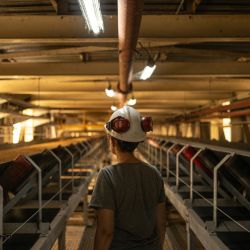
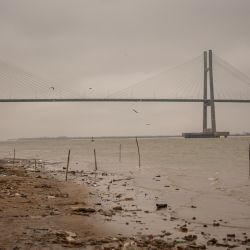













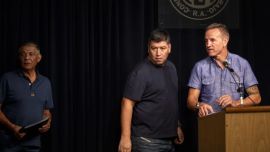


Comments